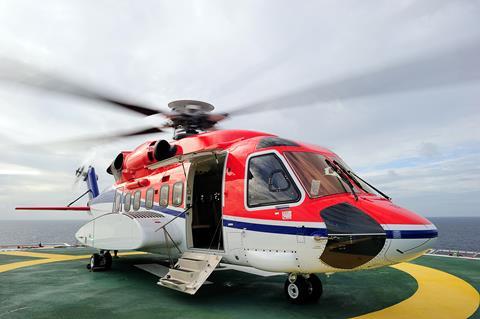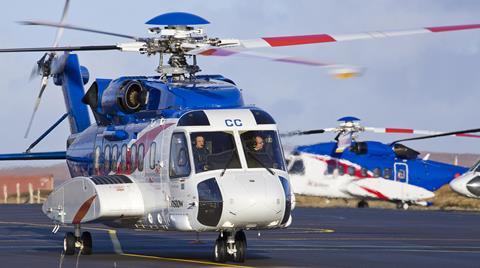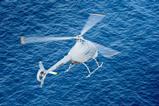Offshore helicopter safety is being put at risk by a shortage of spare parts, particularly main gearboxes (MGBs) for the Sikorsky S-92, as operators resort to “extraordinary actions” to maintain fleet availability, the body representing oil and gas producers has warned.
In a safety notice issued to members, the aviation sub-committee of the International Association of Oil and Gas Producers (IOGP) says that 31 S-92s are currently grounded awaiting replacement gearboxes, a figure which could top 60 airframes by the end of next year.

Supply chain weakness has been an issue for the whole aerospace industry since the sector emerged from the Covid-19 pandemic and has led to shortages of key components.
But the combination of rising demand from the oil and gas industry, the offshore sector’s reliance on a single helicopter type, the S-92, for high-capacity or long-range missions, plus “OEM-level supply chain shortages”, is creating severe aircraft availability pressure.
According to data provided to the IOGP by the three largest S-92 operators – Bristow, CHC and PHI – the three companies have a total of 20 examples grounded, or 13% of their combined fleet, awaiting replacement MGBs, the safety notice states.
An additional three operators have a further 11 S-92s in the same aircraft-on-ground (AOG) condition, it adds.
But the safety notice warns that, based on Sikorsky’s delivery forecast for refurbished MGBs, that total has “the potential to double by the end of 2024”.
Parts shortages are also not confined to gearboxes: one unnamed operator has seen the number of S-92 AOG days at part number level rocket by over 1,300%, rising to 3,009 in 2023 from 214 the previous year, the IOGP says.
As a result, “[overall] dispatch reliability rates have fallen from an industry norm of 96% to around 80%”, it says.
“The reduction of available aircraft, coinciding with increased offshore activity levels, is already impacting operational schedules and causing stress to offshore logistics operations, with operators not always able to meet contracted customer demand.
“It should be highlighted here that this situation is not fully in the control of our contracted operators and that they have already been taking extraordinary actions to maintain availability where they can.”
But those actions are putting increasing strain on MRO providers, the IOGP warns, citing huge increases in the rate of parts cannibalisation, and maintenance extension requests to the OEM which “have increased on average 850%” so far this year.
In addition, it states that the time required to put an S-92 through a 1,500h maintenance check has increased by 75% to 75 days on average, requiring 25% additional manpower.
“These figures represent an unprecedented level of stress on the [MRO] departments, their personnel and management teams,” says the IOGP.
Assurance data compiled by the aviation sub-committee (ASC) “has shown a significant increase in maintenance-related audit findings and also in a perceptible increase in maintenance-related incidents being reported”, it adds.
“The ASC believe the potential and conditions for a serious safety event is clearly growing unless action is taken,” it says.

A previous safety notice issued by the IOGP in May this year had cautioned that the entire aviation industry was experiencing “inventory shortages for critical components” but other observers have been warning of looming problems for the offshore industry for even longer.
“Based on our analysis of aircraft utilisation and downtime we advised the market earlier in the year that it was sleepwalking into crisis – we’ve done the sleepwalk now and the crisis is upon us,” says Steve Robertson of Air & Sea Analytics.
“We have already seen this year that some oil and gas companies have been told by aircraft operators that they simply do not have the available aircraft to fly them as they had planned.”
Air & Sea data shows 36 of the 196 offshore-roled S-92s are currently inactive.
Sikorsky points out that it has been hit by a perfect storm of supply chain issues combined with a faster than anticipated increase in S-92 flying hours – and therefore a higher demand for spares – as the oil and gas industry emerged from a prolonged downturn.
“I think everyone would agree that the global aerospace industry and the supply chain is currently challenged – I don’t think Sikorsky is unique in this,” says Paul Lemmo, the airframer’s president.
But he says the sharp increase in flight hours – up 22% “over the last several years” – was a surprise: “That wasn’t able to be forecasted – our operators certainly did not forecast that for us,” he says.
“When you compound that with some of the supply chain issues, that’s really what’s generating the problem.”
It is worth noting, however, that while operators are flying more than they predicted, overall hours are still below pre-Covid levels, Air & Sea data shows.
Although Sikorsky is “fully staffed”, some suppliers have yet to follow suit. In other cases, veteran workers who retired during the pandemic have been replaced by inexperienced new hires, driving production capacity and quality issues.
Production of long-lead items, notably cast magnesium gearbox housings, has also proved harder to ramp up, creating a bottleneck in the overhaul system, says Lemmo. Such components can take up to a year from start to finish to manufacture, he says.
“We have been spending a lot of money, time and resources in the supply chain, to work with all of our suppliers who have had challenges to help them through the process,” he adds.
Sikorsky has invested “tens of millions of dollars” in its supply chain, Lemmo says, through the purchase of raw materials, making accelerated payments or financial support, and crucially to set up a second source for the gearbox castings.
However, given that it takes up to four years to qualify a new supplier for such a critical component, a second source will not provide a quick fix for the problem.
Nonetheless, Lemmo says Sikorsky has increased gearbox output by 40% year on year – it will ship 40 units this year, up from 28 in 2022 – and deliveries will rise further in 2024.

Although conceding that “operators would like to be in a fully supplied position right now”, Lemmo insists the situation is “improving” and the supply tightness will ease over the coming months.
“In terms of the main gearbox, our current projection is that will get there at the end of 2024. But I would like to believe that along the way, through next year, as we start delivering more and more gearboxes, that [operators] will start feeling that relief,” he says.
“I understand that it’s not all the way there right now, but again, the situation will get better as we continue to work with our suppliers and have more [spares] flow through the line.”
However, Lemmo declines to comment on the IOGP’s warning that things may get worse before they get better. “We don’t control how and when the operators fly the aircraft so it’s hard for us to predict. All we know is what they tell us in terms of their potential needs – for example for gearboxes.
“Now if going into ’24 they decide to fly even more, or put more aircraft back into service, that could generate more [spares] needs that we are not currently anticipating. But based on what we know today we feel that we’ll be through that backlog at the end of next year.”
In the meantime, the IOGP says its members should “engage calmly with the operators”, taking care not to penalise them for a situation that is no longer “fully in [their] control”.
“If we value the safety of our operations and the resilience of our critical contracted partners, now is not the time to add to their burden, demand that contract terms written under different conditions are met or apply punitive financial penalties for not meeting aircraft availability targets.
“These will not improve availability but will worsen the operators’ position further and potentially add further stress and risk to their maintenance departments,” the safety notice states.
It calls for IOGP members to work more closely together on a regional basis to “reach collaborative agreement on the most productive use of available resources and support measures that reduce safety risk.”
The ASC will also engage with Sikorsky “and will work with other industry stakeholder groups to seek the best path to a sustainable resolution”.
In some senses, the industry is suffering from its dependence on a single aircraft type to perform the vast majority of its long-range or high-capacity missions. Since the Airbus Helicopters H225 was largely removed from the oil and gas sector following a fatal crash in 2016, the S-92 has had a virtual monopoly in the upper end of the offshore sector.
Although super-mediums such as the H175 and Leonardo Helicopters AW189 have taken some market share, they lack the full 19-seat capability offered by the Sikorsky type.
Robertson agrees, describing the S-92 as a “key asset” for operators in multiple regions due to its “utility, performance and safety record”. However, he adds: “these are expensive machines to have sat idle on the ground.
“They need to be flying and right now the demand is there if the parts are available to keep them on the line.”































